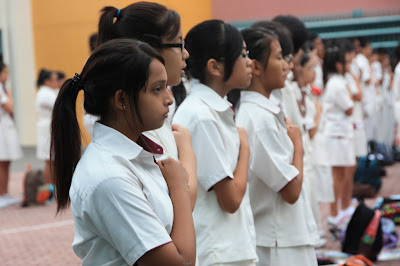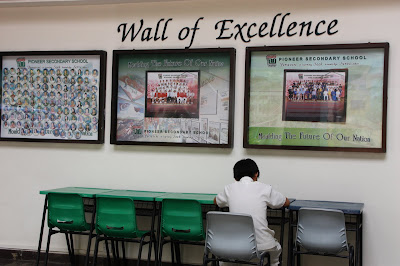On the first morning at Pioneer Secondary School, we were greeted by the 4 main languages of Singapore right at the school gate: Malay, Chinese, Tamil and the official language of education, English. Each student also attends lessons in their home language, so most of the students are at least bilingual, which is quite impressive.
Each school day starts in the school yard, with a tangible community spirit, often missing in our school. All students, dressed in their white uniforms, in orderly lines, watch the flags go up, sing the national anthem and say the pledge. The first morning, there was also a welcoming ceremony for us foreign visitors.
After this routine, there is a quiet reading session for half an hour, during which all the students sit on the ground, and read something in English. Teachers go round checking that everybody has the right texts, and if not, they are sent to stand and be ashamed at the back of the yard. Obedience, impeccable, gracious behaviour, knowing your role and place - at first glance, at least these struck me as driving values in this school.
Our students really stood out like sore thumbs in the orderly white crowd. In fact, they had considerable trouble seeing anything positive in school dress codes, which are almost non-existent in our school. Girls having to tie their hair back, no flip-flops, no revealing spagetti straps - it was finally beginning to dawn on them that this really was not a holiday in an exotic destination but a working trip to represent our country and to respect the culture of the host school. An excellent lesson for our students coming from an individualistic, relatively free and easy, express yourself and your individuality, do as you wish school culture.
Not only were the school values implied by the daily routines but they were visibly present all around the school. You have already seen the vision of the school - Passionate learners, gracious citizens - in previous photos. Behind the podium you can read the school mission: We provide opportunities for students to develop their potential and be competent, caring and responsible individuals who will contribute effectively to society.
The underlying school values were high up on another wall around the main school yard.
And even above the main entrance there were words to indicate what the role of this school is in society.
The concept of learning environments is big in Finland at the moment. Our Ministry of Education is currently generously funding projects to develop and diversify the learning environment. In Pioneer Secondary, I observed many great initiatives that seemed to be a natural part of Singapore schools without any separate projects. For example, all the schools we visited had a green, open plan - for obvious climatic reasons.
As we are closed inside the school building to keep warm half of the year, being able to sit outside all through the year, seemed a lovely idea. We realized very soon, though, why Singaporeans would rather escape into air-conditioned buildings in a constantly hot and humid climate.
Singapore schools seemed to be very target driven, from top to bottom, and all their achievements were proudly displayed around the school.
Instilling the community spirit was also enhanced by allowing students to contribute to their physical school environment.
I was truly impressed by all this student team effort, and convinced that it really improves the students'
ownership of their learning environment.
One more thing that caught my attention, like in many other foreign schools before, was the involvement of parents in the school community. In a Finnish high school (for 16-19-year-olds) parents have no role whatsoever, other than coming to school once a year for a formal information session where they are, to a large extent, just passive recipients listening to the teachers' lectures. In Pioneer Secondary, we saw some parents at school every day, they came along to some of our excursions, and some of them ran their food stalls in the school cafeteria. This mother's noodles were the favourites for many of us.
Naturally, our students were surprised by the school lunctime routines, which were so different from our standard, one-course, free of charge school meals. Having a choice of all the different ethnic cuisines really appealed to them, although they did realize that the variety and choice came at a price.
In hindsight, now, I feel that despite the major differences highlighted in this post, there were surprisingly many similarities in the working cultures of Singaporean and Finnish schools. But those will be the topic of another blog post.
I miss the buzzing, lively, pastel-coloured Pioneer community that opened the door to Singaporean culture to us and welcomed us so heart-warmingly. In a week, you can only scratch the surface, so I am looking forward to another visit to this fascinating city state - to find the time to try the Singapore sling, too, which I missed during this first visit. While waiting for that chance, I can reminisce by looking at this beautiful batik painting by one of the Pioneer students, which was presented to us, and now brings colour to the wall of our school hallway.















1 comment:
Great post.Learning different languages is hard but fun.We were able to grasps the culture of every languages we translate.A lost in Tamil translation or any translation should not hinder us to know exactly about one's history and culture.
Post a Comment